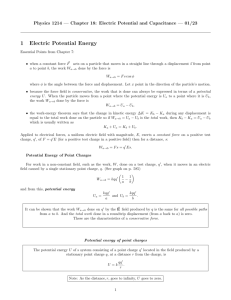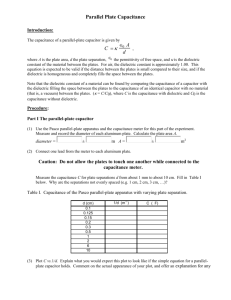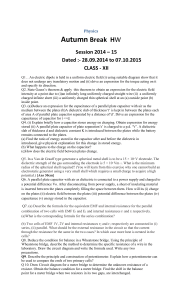Chapter 19 Notes
advertisement
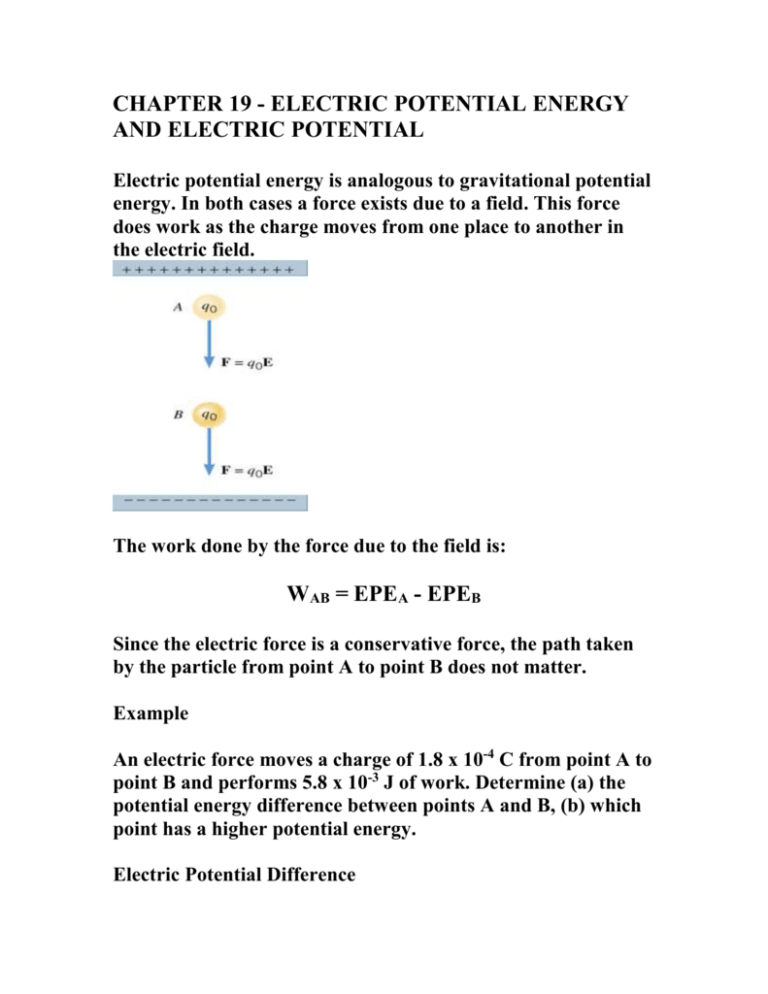
CHAPTER 19 - ELECTRIC POTENTIAL ENERGY AND ELECTRIC POTENTIAL Electric potential energy is analogous to gravitational potential energy. In both cases a force exists due to a field. This force does work as the charge moves from one place to another in the electric field. The work done by the force due to the field is: WAB = EPEA - EPEB Since the electric force is a conservative force, the path taken by the particle from point A to point B does not matter. Example An electric force moves a charge of 1.8 x 10-4 C from point A to point B and performs 5.8 x 10-3 J of work. Determine (a) the potential energy difference between points A and B, (b) which point has a higher potential energy. Electric Potential Difference Electric potential difference is defined as the change in electric potential energy per unit of charge as the charge moves from one point to another in an electric field. The equation used to calculate electric potential is: V = EPE/q where V is the electric potential, EPE is the electric potential energy, and q is the magnitude of the charge upon which work is done. The unit of electric potential is the volt which is one joule per coulomb. Electric potential difference is more useful to us since it describes the work done on a charge q by the field as it moves from point A to point B. VB - VA = (EPEB /q) - (EPEA /q) = -WAB /q Since, for a positive charge, the potential energy is greater at A than at B, VB - VA is a negative number equal in magnitude to the work per unit charge done by the field as the charge goes from point A to point B. We say that point B is at a negative potential relative to point A. If we move a negative charge from point A to point B, the potential difference is positive and we say that point B is at a positive potential with respect to point A. Example In the previous example, 5.8 x 10-3 joules of work was done on 1.8 x 10-4 C of charge by the electric field as it moved from point A to point B. Find the potential difference between point B and point A. Notice that the sign of the potential difference depends on which point we consider to be at zero potential, but in either case, point A is at the higher potential. Remember a positive charge always accelerates from a region of higher electric potential to one of lower electric potential. A negative charge always accelerates from a region of lower electric potential towards a region of higher electric potential. Since potential difference is the electric potential energy per unit of charge, you can find the potential energy a charge has by multiplying the potential difference by the value of the charge. Example The anode(positive terminal) of an X-ray tube is at +125,000 v with respect to the cathode(negative terminal). How much work is done by the electric force when an electron is accelerated from the cathode to the anode?If it is initially at rest, what kinetic energy does the electron have when it arrives at the anode? Neglecting relativistic effects, how fast is it going? Me = 9.11 x 10-31 kg A unit of energy that is often used when discussing the energy of an atomic particle is the electron volt (eV). Its magnitude is equal to the energy change of an electron when it moves through a potential difference of one volt. 1 eV = 1.6 x 10-19 joules Other commonly used units are MeV which is one million eV and GeV which is a gigaelectron volt equal to one billion eV. Electric Potential Difference Created by Point Charges A positive point charge creates a potential function whose graph looks like the figure above. We recognize this as a hyperbola which indicates the variable relationship is inverse. In fact, it can be shown that the equation for the potential function of a point charge is: V = kq/r where V is the potential(graphed on the Y axis) and r is the distance(graphed on the X axis) from the charge q that causes the potential to exist. We can see from this equation that the potential at an infinite distance would be zero, so V gives us the potential relative to the potential at an infinite distance. Since the charge causing the potential is positive, the potential is everywhere positive and varies from zero to positive infinity. Example There is an electric potential of +130 V at a spot 0.25 m away from a point charge. Find the magnitude and sign of the charge. If the charge that creates the potential is negative, the potential varies from zero to negative infinity. The two examples above show how the potentials vary for charges that are identical in magnitude but opposite in sign. In the case of the positive charge the potential is positive and means that you would get 300 joules of energy out if you released a +1.0 Coulomb charge at the 1.2 m mark and allowed it to move to the right until it hit a target at a nearly infinite distance. In the case of the negative charge, you must do 300 joules of work in order to move the positive charge away from the negative charge nearly an infinite distance. Remember, if we must put work in to move the object to a zero potential point, we have negative potential energy. If we get work out as we move to a zero potential point, we have positive potential energy. When two or more charges are present creating the potential, you simply find the potential due to each charge and add them algebraically. Remember potential difference is a scalar quantity. Example Four point charges are arranged as in the drawing. The value of q is 2 x 10-6 C and the distance d is 0.96 m. Find the potential at point P. Equipotential Surfaces An equipotential surface is a surface which has the same electric potential everywhere. For a single point charge, these surfaces are concentric spheres. The electric force does no work on a charge as it moves on an equipotential surface. Work must be done to set it in motion by some outside force, but the electric field associated with the equipotential surface does no work. The electric field lines associated with an equipotential surface always form right angles with the surface and point from high potential to low potential. If motion along the surface is at right angles to the direction of the electric force, the electric force is not doing any work. As we move from one equipotential surface to another, the potential changes with the distance moved. The amount of change per unit of distance can be calculated using the equation: E = -ΔV/Δs where E is called the potential gradient and has units of volts per meter. The potential gradient has the same value as the component of the electric field in the direction of the potential gradient. If we choose the directions so that they are the same, the magnitude of the electric field will be the same as that of the potential gradient. Notice that volt per meter will reduce to newton per coulomb. Example The inner and outer surfaces of a cell membrane are charged negatively and positively respectively. A potential difference of about 0.070 v exists across the membrane which is 8.0 x 10-9 m thick. Find the magnitude of the electric field in the membrane. Capacitors and Dielectrics A capacitor is an electrical device consisting of two conductors placed near each other without touching. Negative charge is applied to one plate and an equal amount of positive charge is built up on the other plate. An insulating material called a dielectric is normally found between the two plates. Since one plate is positive and the other is negative, a potential difference exists between the two plates. The amount of charge on the plates and the potential difference are directly proportional, so an equation relating the two can be developed. The capacitance of the capacitor is defined as the amount of charge per volt that can be placed on the capacitor. The equation is: C = q/V where C is capacitance, q is the magnitude of the charge on either plate in Coulombs, and V is the voltage across the plates. The unit of capacitance is the farad(F) which is one coulomb per volt(C/v). One farad is a very large capacitance. Usually capacitors are rated in microfarads (1 μF = 10-6F) or picofarads (1 pF = 1012 F). Example What voltage is required to store 72 μC of charge on the plates of a 6.0 μF capacitor? A dielectric material inserted between capacitor plates serves two purposes. It acts as an insulator and it increases the capacitance by a factor k. In a dielectric, the molecules become polarized due to the electric field generated by the charge on the capacitor plates. The polarized molecules generate an electric field that opposes the field produced by the charge on the capacitor. The electric field within the capacitor is weaker with the dielectric than it is without the dielectric. The ratio of the two field strengths is called the dielectric constant k. The value of k depends on the nature of the dielectric material. When a capacitor stores charge it also stores energy. Work must be done to move a negative charge from a positive plate to a negative one. As the amount of charge increases, the amount of work required to transfer a unit of charge also increases. The total work done is equal to the total of each of the charges transferred multiplied by the voltage each charge must be moved through. Since the voltage will vary from 0(no charges transferred yet) to some maximum value V, the average voltage will be ½V. The equation for the total work done becomes: W = (½)qV Since q = CV, W = (½)CV2 Since this equation represents the work done while charging the capacitor it also can be used to calculate the energy stored in the capacitor. Example The electric potential energy stored in the capacitor of a defibrillator is 73 joules and its capacitance is 120 μF. Find the potential difference across the capacitor. The capacitance of a capacitor depends only on the area of the plates, the distance between the plates, and the dielectric constant of the material between the plates. The equation is: C = kεoA/d k is called the dielectric constant and is a factor that is multiplied by the capacitance without a dielectric to determine the capacitance when a dielectric material is inserted between the capacitor plates. Example The outer surface of an axon membrane (dielectric constant = 5.0, thickness = 1 x 10-8 m) is charged positively and the inner portion is charged negatively. Assuming that the axon can be treated as a parallel plate capacitor with a plate area of 5.0 x 10-6 m2, find its capacitance. P 597 Questions 1, 2, 3, 4, 8, 9, 10, 11, 12, 15 P 598 Problems 1, 3, 5, 7, 11, 12, 13, 15, 16, 21, 23, 27, 28, 30, 31, 36, 37, 38, 39, 41, 54
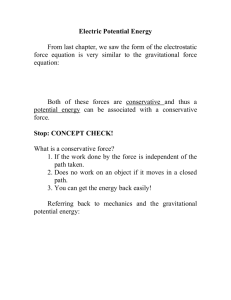
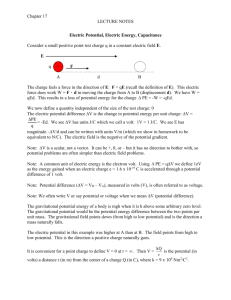
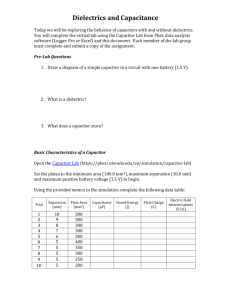


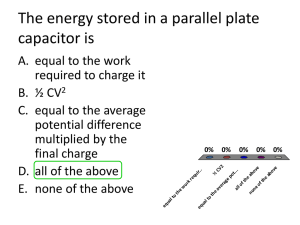
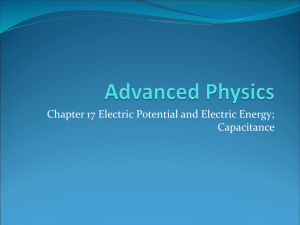
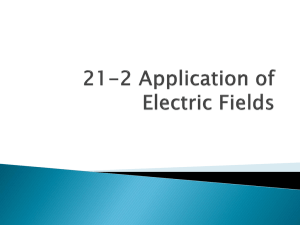
![Sample_hold[1]](http://s2.studylib.net/store/data/005360237_1-66a09447be9ffd6ace4f3f67c2fef5c7-300x300.png)
